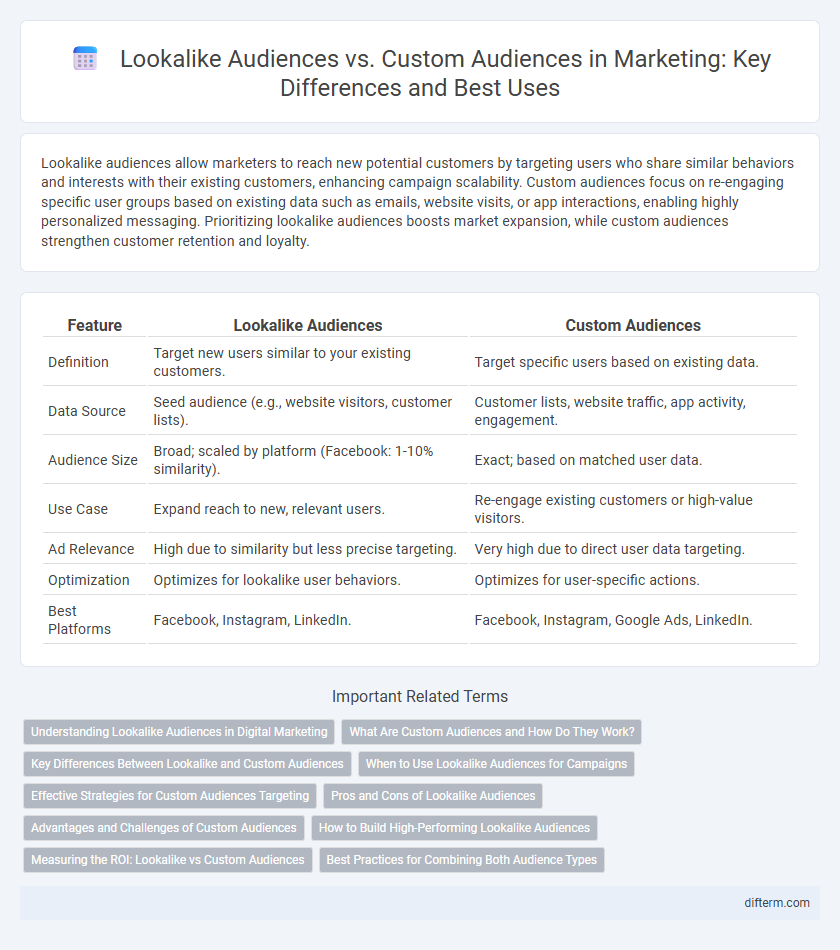Lookalike audiences allow marketers to reach new potential customers by targeting users who share similar behaviors and interests with their existing customers, enhancing campaign scalability. Custom audiences focus on re-engaging specific user groups based on existing data such as emails, website visits, or app interactions, enabling highly personalized messaging. Prioritizing lookalike audiences boosts market expansion, while custom audiences strengthen customer retention and loyalty.
Table of Comparison
| Feature | Lookalike Audiences | Custom Audiences |
|---|---|---|
| Definition | Target new users similar to your existing customers. | Target specific users based on existing data. |
| Data Source | Seed audience (e.g., website visitors, customer lists). | Customer lists, website traffic, app activity, engagement. |
| Audience Size | Broad; scaled by platform (Facebook: 1-10% similarity). | Exact; based on matched user data. |
| Use Case | Expand reach to new, relevant users. | Re-engage existing customers or high-value visitors. |
| Ad Relevance | High due to similarity but less precise targeting. | Very high due to direct user data targeting. |
| Optimization | Optimizes for lookalike user behaviors. | Optimizes for user-specific actions. |
| Best Platforms | Facebook, Instagram, LinkedIn. | Facebook, Instagram, Google Ads, LinkedIn. |
Understanding Lookalike Audiences in Digital Marketing
Lookalike audiences leverage existing customer data to identify new users with similar behaviors and interests, enhancing targeting precision in digital marketing campaigns. By analyzing demographic and psychographic profiles, platforms like Facebook create audience segments that mirror high-value customers, increasing the likelihood of conversions. This approach optimizes advertising spend and boosts campaign ROI compared to broader custom audience targeting strategies.
What Are Custom Audiences and How Do They Work?
Custom audiences consist of a business's existing customers or users, created by uploading contact lists, app activity, or website traffic data to advertising platforms like Facebook Ads. This approach enables precise targeting by matching known user information, such as emails or phone numbers, with platform profiles to deliver highly relevant ads. Custom audiences improve campaign efficiency by focusing on warm prospects, increasing conversion rates, and reducing ad spend waste.
Key Differences Between Lookalike and Custom Audiences
Lookalike audiences are created by algorithms that identify new users with similar behaviors and characteristics to an existing custom audience, expanding reach to potential high-value customers. Custom audiences consist of data sets imported directly by marketers, such as customer emails or website visitors, enabling highly targeted campaigns based on known user information. Key differences include source data origin, targeting precision, and scalability, with lookalike audiences optimizing acquisition through modeled similarity and custom audiences focusing on direct engagement with established contacts.
When to Use Lookalike Audiences for Campaigns
Lookalike audiences are ideal for scaling campaigns by targeting new potential customers who share characteristics with your best existing customers. They are most effective when you have a high-quality source audience of at least 1,000 engaged users to create a precise and relevant lookalike model. Use lookalike audiences when expanding reach, increasing brand awareness, or driving conversions beyond your current customer base.
Effective Strategies for Custom Audiences Targeting
Custom audiences allow marketers to precisely target existing customers or leads by using data such as email lists, website visitors, and app users, driving higher engagement and conversion rates. Utilizing CRM integration and dynamic segmentation enhances personalization, making campaigns more relevant and effective. Employing retargeting strategies with custom audiences boosts ROI by focusing efforts on individuals already familiar with the brand.
Pros and Cons of Lookalike Audiences
Lookalike audiences enable marketers to reach new potential customers by targeting users who share similar behaviors and interests with existing high-value audiences, increasing the chances of conversion. They offer scalability and efficiency, but may lack the precise targeting control and specificity provided by custom audiences, which are based on known customer data. However, lookalike audiences might result in lower engagement rates if the model fails to capture niche segments, making continuous optimization essential for maximizing ROI in marketing campaigns.
Advantages and Challenges of Custom Audiences
Custom audiences offer targeted marketing advantages by leveraging existing customer data like email lists and app activity, enabling highly personalized campaigns that improve conversion rates and customer retention. Challenges include maintaining data privacy compliance and the necessity of continually updating audience lists to reflect changes in customer behavior and preferences. Effective use of custom audiences requires robust data management and integration with analytics tools to maximize return on ad spend (ROAS).
How to Build High-Performing Lookalike Audiences
Building high-performing lookalike audiences begins with leveraging high-quality custom audience data, such as top customers or frequent website visitors, to ensure the algorithm identifies valuable traits accurately. Refining the source audience size to an optimal range, typically between 1,000 to 5,000 users, enhances the precision of the lookalike model and improves campaign ROI. Utilizing data segmentation, including purchase behavior and engagement metrics, allows marketers to create tailored lookalike segments that drive higher conversion rates and lower cost per acquisition.
Measuring the ROI: Lookalike vs Custom Audiences
Measuring ROI between lookalike and custom audiences involves analyzing conversion rates, cost per acquisition, and overall campaign effectiveness to determine the most profitable segment. Custom audiences often yield higher ROI due to targeting existing customers or leads with known engagement, while lookalike audiences expand reach by finding new users resembling top customers, potentially increasing scale but with varied cost-efficiency. Evaluating attributed sales and customer lifetime value across both audience types provides critical insights for optimizing marketing spend and enhancing revenue growth.
Best Practices for Combining Both Audience Types
Combining lookalike audiences with custom audiences enhances targeting precision by leveraging existing customer data to identify new potential customers with similar behaviors. Best practices include segmenting custom audiences based on purchase intent or engagement levels before creating lookalikes, ensuring higher relevance and conversion rates. Integrating these audiences in layered campaigns allows marketers to maximize reach while maintaining personalized messaging, optimizing ad spend efficiency.
Lookalike audiences vs custom audiences Infographic

 difterm.com
difterm.com